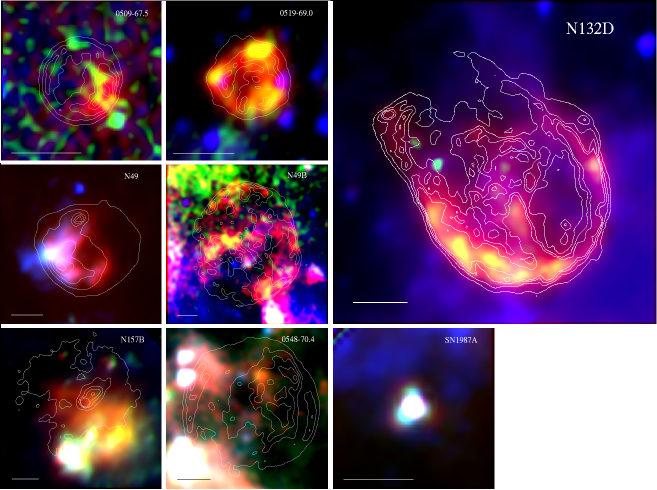AKARI Results
AKARI Highlights III: Supernova remnants in the Large Magellanic Cloud unveiled by AKARI
- A new insight to the dust processing in the supernova remnants -
AKARI has revealed unprecedented images of supernova remnants in the Large Magellanic Cloud. The data shows presence of a significant amount of new, warm dust component. This implies that the efficiency of supernova remnant shocks in destroying the interstellar grains has been overestimated.
The Large Magellanic Cloud is a companion of the Milky Way about 160,000 light years from us. Its relatively short distance and the location that we can see the entire activity of the galaxy provide a unique opportunity to study the interstellar medium, and AKARI carried out a systematic observations of large-area toward the Large Magellanic Cloud. Among more than forty supernova remnants that have been reported, about half of them are included in the AKARI observed region. The near- and mid-infrared Camera (IRC) onboard AKARI detected infrared emissions from eight supernova remnants, and unveiled their detailed structures in mid infrared for the first time as seen in Figure 1.

Figure 1: Three colour composite images of eight supernova remnants in the Large Magellanic Cloud from the images at 7 (Blue), 11 (Green) and 15 (Red) micrometers taken with the Near- and Mid-Infrared Camera (IRC) onboard AKARI. Contours indicate the intensity of the X-ray emission observed by the NASA's Chandra X-ray observatory. The line in the bottom of each image indicates the distance scale of 20 light years.
Figure 1 is a three-color composite from the 7 (Blue), 11 (Green), and 15 (Red) micrometers, and shows various features of the supernova remnants. Most of the remnants in the figure have well-defined shell structures, which mainly consist of swept-up interstellar materials by supernova shocks. The AKARI results indicate that the infrared emissions of those supernova remnants with strong resemblance to the X-ray emissions (contours) seen in the figure originate mostly from dust heated by hot gas emitting X-rays. The AKARI data will shed light on the nature of supernova remnants and the lifecycle of interstellar dust.
At its last evolutionary stage, a massive star experiences a catastrophic explosion, returning a huge amount of energy and heavy elements into the space. A remnant after the explosion, a supernova remnant, can help us understand the explosion itself as well as its role on the evolution of the interstellar medium. Interstellar dusts are destroyed mainly by supernova shocks, and it is essential to understand this process, because dust is a seed of another star as well as a planet like the Earth.
Using the AKARI data at 11, 15, and 24 micrometers, we found the presence of a significant amount of new, warm dust component. This implies that the amount of dust grains destroyed by the supernova remnant shocks is less than previously thought. Especially thanks to the data at 11 and 15 micrometers unique to AKARI, we found the presence of warm dust components. This implies that the amount of dust grains destroyed by the shocks at the supernova explosion is less than previously expected. Further analysis with the AKARI data will greatly improve our knowledge on a supernova remnant itself as well as its influence toward surroundings including dust grains.
This research has been carried out by Miss. Ji Yeon Seok and Prof. Bon-Chul Koo at Seoul National University, Korea, Prof. Takashi Onaka at the University of Tokyo in collaboration with the researchers in Seoul National University, the University of Tokyo, Nagoya University, the Pennsylvania State University, University of Toronto, Institute of the Space and Astronautical Science/Japan Aerospace Exploration Agency, and Sejong University.
Materials
- Figure 1 (© JAXA)
- Figure 1 Individual (© JAXA)





